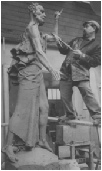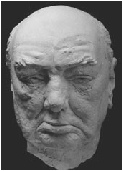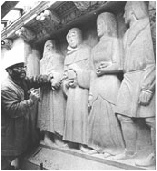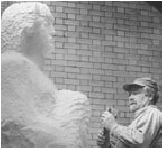David McFall R.A. (1919 - 1988)
Sculptor





In 1986 Dr Evelyn Silber published her comprehensive work The Sculpture of EPSTEIN and David McFall was asked to write a review by the Royal Academy Friends magazine. The following is what he wrote but as far as is known it was not published. McFall had a complex relationship with Epstein, who he clearly idolised, but the end of his relationship with Epstein undoubtedly caused him great personal pain. McFall was meticulous in keeping diaries, recording both work progress and social engagements, but he destroyed all his diaries before 1954 covering the Epstein years.
“The Sculpture of EPSTEIN by Dr. Evelyn Silber published by Phaidon. With some personal recollections of the sculptor by David McFall RA Copyright D.B. McFALL R.A. Sculptor 10 FULHAM PARK GDNS LONDON SW6 4JX.
It was a harrowing task ploughing through this hefty and expensive tome on Epstein - regurgitating the stormy conflicts and dramas of his last eighteen years when I came to know him so well. Dr. Silber wisely skirts this emotive minefield and has produced a reference work ofotherwise commendable thoroughness. Virtually every traceable work is illustrated inblack and white with details of its origin, dimensions, "provenance", etc. Of necessity the text contains many quotations from other sources, for which full attribution is given. There is also a comprehensive index. I have to say, however, that such a format underlines quantity rather than quality and stops short of showing Epstein's finest pieces in the best light. For example, the choice of the back view of LUCIFER on the back of the book-jacket is ambiguous to say the least.The rejection of this bronze - first by the Tate and then the Fitzwilliam - sparked off such a tantrum that Mrs. Epstein and I who were present were struck dumb and helplessby the sheer ferocity of Epstein's anger. He paced the floor like a menacing lion.Shaking his fists at the ceiling and shouting at us - "I will not be overlooked, Iwill NOT be overlooked." She and I later contrived to get it accepted by Trenchard Cox who was then curator ofBirmingham City Art Gallery - where LUCIFER still stands incongruously in the public cafeteria. We were given a full civic reception for the unveiling at which Epstein made a rambling and totally inaudible speech.
The Epsteins were convinced that I was well connected despite my denials. My surname as well as my mother's maiden name coincided with two of their first supporters: Haldane McFall and Ambrose McEvoy! Not to lose sight of this newly published book, the question is - what would Epstein himself have had to say about it ? The long years of adverse criticism naturally put him on the defensive with art historians, curators, journalists and the like - whom he regarded as parasites, unless they praised him unequivocally. But my happiest memories of Epstein are ineradicable: I was still in my twenties when we met for the first time. He wanted an inscription done quickly on a bust of Franz Reizenstein. It had just been cast in plaster, and was still wet and soft. It reposed on the hearth in a bid to dry it out somewhat - which struck me as a cheerfully optimistic but futile gesture. Eric Gill had died in 1941 leaving behind him a new movement of fine letter-cutters, by chance including myself - and this is how I came into Epstein's ecurie. It would be misleading to say that I became his regular assistant, as far as I know he never had one. I already had my own studio in Chelsea and lived conveniently close by at that time. We had a flexible arrangement which suited us both very well. He would phone me at eight o'clock in the morning if he needed me that day. He would say "How are you placed Mack-fal ?" His East-side accent was inimitable, e.g. "Scoundels boi moi woik". I would abandon my own work and head off for Hyde Park Gate without a second thought, and I do not recall that I ever refused him once. Invariably, I would find him presiding at breakfast. Courteously he would pour me the remains of the coffee while enquiring with a twinkle in his great, mischievouseyes - if I had eaten ...The table would be piled high with every available fruit like a harvest festival. Sculpture demands prolonged physical exertion and Epstein held that a full stomach was the prerequisite for stamina to start a working day on. The debris of porridge, kippers, sausage, bacon, eggs, toast and all were evidence of a hearty appetite. He would roar with derision at some item on the BBC news – and then we'd straight away get down to action. I saw him as a God-like patriarch - a man of prodigious talent and vision, providing andprotecting, a giant of creative force, a hero among sculptors. There must have been more than a whiff of idolotary on my part, which was to sustain me throughout our close association. Unwittingly, I was cast as a passive witness to the ‘sturm und drang’ of a Greek tragedy.
The first ritual of the day upon rising was to get the studio stove going in winter-time, and usually it was a blazing inferno by the time I got there. I still think of him ruefully when wrestling with my own cast-iron brute. The Epstein studio was a nightmare of congestion, there were no facilities worth mentioning. Busts of the famous jostled for elbow room with the infamous. Pyramids of damp smelly chippings accumulated over the years crept towards an avalanche of coke dumped next to the clay bin. Modelling stands, buckets of partly prepared clay, step ladders and timber for armatures left little room for manoeuvre. All was dominated by the glowering presence of the subiaco ECCE HOMO as can be seen in Geoffrey Ireland's photographs of that period. I very soon realised that the superb pieces which had so inspired me as an art-student in Birmingham belonged to the past. There was nothing here comparable to the VISITATION, the bust of Mrs. Epstein in a mantilla, Peggy-Jean as a sick child, busts of Conrad, Lord Fisher or the Duke of Marlborough, etc. What had happened, had circumstances driven him to turn out too many pot-boilers? I once overheard a tactless American lady ask him how many children he had ... "Wat"he expostulated - "Did you expect me to keep count !" With such inexhaustible fecundity he was at the mercy of skilful and reliable plaster-moulders. Giudici was all of the first and none of the second, he was short on patience and resented the time needed to chip away the waste-moulds carefully with all their diabolical undercuts - without damaging the cast itself. "Piff-paff" he would say "That's how I like to finish - tomorrow I'm off to theraces". That put the lid on it. Epstein exploded ... telling Giudici to pack his kit and get out. "And don't come back here" he shouted as the door slammed with finality. He didn't. Sweet and demure as a debutante, for he was a very funny mimic, Epstein turned to me and coyly asked who did my moulding ... Admitting that I did my own he wheedled me into casting the NEHRU for him. Agog at the responsibility, I did my best to back out, but it was useless. Such was his winning charm - "As a special favour Mack-fal... to save the NEHRU ... just handle it as you do your own" and so on. And that is how I got hooked into the plaster bin. Like most sculptors, I hated working in plaster. Indeed many a student has lost the term's work through incompetence at this stage. Next day I moved to a tiny back-yard clad in 'wellies', plastic 'mac' and sou'wester. It was the only place to clean out the mould, and a very wet job which called for water-pressure. Epstein's technique was compounded of countless microbic pellets of sticky French clay right the way through from the core, so that there were smaller and smaller NEHRU's inside the outside one - just like a Russian doll. So here I stood with freezing feet aiming the garden hose into the Pandit's brain-box with cold water dripping off the end of my nose. The result was a flawless cast which delighted the master - "Why" he remarked with obvious satisfaction "you have even maintained the exact angle at which I modelled it !" I was to do lots of other portrait busts and heads including the unfinished Churchill. If a sculptor has to do his own plaster-moulding it reduces his output by half, which in Epstein's case might have been no bad thing. The next stage in the cire-perdu method is the wax, and Epstein was punctilious in checking his waxes at the foundry. This is why any posthumous bronzes are manifestly worthless. The lumpiness of his modelled surfaces was peculiarly well suited for molten bronze which sought out these irregularities. Broken surfaces also responded well to patination by holding the "tone" of the finished bronze. Not all founders are good patineurs, but one who is brilliant at it is Roberto Fiorini, son of Giovani who originally worked with Cassandre and Gatai. Dr Silber mistakenly refers to the old man who was born in Rome as Furini.
Meanwhile our friendship became more and more confidential and although I still revered him as ever, our relationship underwent a subtle change. Did I detect in him a reflection of my own paranoic sensitivity, even a hint of masochistic insecurity? Walking together up Gloucester Road one evening, I recall that we passed a tramp sheltering in a doorway. "I'll finish up like that Mack-fal" (he meant it). It was near to Karnak's bookshop which had Roy Campbell's "Light on a dark horse" displayed prominently in the window - Instant rage, consternation ! "Lies – all lies - it's a pack o'lies" Epstein bellowed, to the alarm of the tramp as well as myself. Me thought he protesteth too loud ... so I bought and read Campbell's book out of curiosity. Lies or not I found it most entertaining. The only sculptors I never heard him disparage were George Grey Barnard, Bill Zorach and Constantin Brancusi, to the last of whom he generously wrote me an introductory letter. I later called on him in Paris where he still had his studio in the impasse d'enfer. All of the others were "fakers" (a favourite epithet of Epstein's). In a rash moment I asked if he thought me a "faker" too ... his instant riposte was to surprise me "We are all fakers Mack-fal!"
He was also to reveal an occasional uncharacteristic uncertainty when he would frankly seek my opinion, as in the case of LAZARUS, his last great carving. It happened like this: he had stored certain early pieces begun before the first world war in Harrods Depository and had been requested to retrieve them. One of these, which came back to the studio, was a figure in Hopton-wood stone called MATERNITY, 23 (plate 5). This was the time-hardened stone which Epstein slowly and painfully transformed into LAZARUS with blunt chisels and wood rasps. It was a fascinating piece of transfiguration to observe. If you were to compare photos of the two figures - one can clearly be seen inside the other. To begin with LAZARUS had feet. They were the tortured feet of one who had survived untold agonies, feet which could walk no further. Race memory ... the Diaspora? Crucified feet. But the lower legs were too short. Too short by far, like stumps. Querulously, he asked me what I thought. I knew that he knew the legs were too short - I hesitated, then decided that it was not the moment to be evasive. I replied quietly that there was only one remedy - and that was to carve out the feet so as to gain length for the legs. He didn't answer but I had confirmed his own conclusion. That is just what he did, and I was working close beside him on the busts of the two Abyssinian "princesses" at the time. As Epstein chiveyed away at the feet, he reached a point when the stone became top heavy. We were within a whisker of disaster! There was no warning creak from the wooden floor, but I felt a very slight movement in the boards where I stood. Epstein was on his knees unable to raise himself at all, he looked up as if beseeching me - "Mack-FAL!" he gasped. Miraculously a shortish timber of 3" x 4" was lying within my reach and, in one almost acrobatic leap, I grabbed it and jammed it against a ridge of the embalming clouts – and so scotched the fall of LAZARUS. Poor Epstein was pale with shock, he dropped his tools and shuffled out of the studio to retire upstairs. Subsequently LAZARUS was dowelled on to a heavy base for the first Battersea Park sculpture exhibition. I concur with Dr. Silber that LAZARUS is a masterpiece both solemn and poignant. The more so as I recall that it so nearly crushed the sculptor to death …
Tuesday afternoons were open house and there was always music. Dorothy Moggeridge, the pianist, would appear regularly, her fingertips reinforced with elastoplast - evidence of constant practice. The house was always full of children, they would scamper around the tea-table and chase each other under the grand-piano. No one scolded them, they were cherished.Epstein beamed with delight at their antics and presently the pianist would begin one of Beethoven's three last sonatas, the op. numbers 109, 110 or 111 - all of which I got to know by heart. Indeed, when I catch the opening notes of the op. 110 I still catch my breath for an instant. Dear Peggy would rummage through her voluminous hand-bag until sleep overtook her, and her head would droop down on to her chest. She gave her last breath for Epstein. As they carried her out to an ambulance in that awful winter of 1947 her last words: "Don't let Epstein see me like this - see that he has his gloves ..." A parallel with Rodin's Rose Beuret comes to mind. Last Act - scene I. Within hours of her death the persona of the household switched over. Miss Moggeridge retraced her steps. David Rush, the Irish cook, made off in haste for the Emerald Isle and I was asked for my latch-key of No. 18. Working there became very awkward, not to say impossible from then on. We had to get the big head of Smuts over to my studio for casting, and we all but lost it in the shifting around. The plaster was knocked over and shattered into fragments, Epstein complained that I had made it eggshell thin - (I had cast it as light as I dared so that we could transport it).
Sunday morning we often took a stroll in Richmond Park. I'd park my old taxi in the mews behind the studio and wait for him to appear at the back door. I needed my sense of humour, for there were amusing moments too. He was at work on the Llandaff MAJESTAS and he wanted me to make up the nimbus. To see him wading through the ferns in overcoat and scarf, impressario's hat and with arms outstretched - "Make it this size Mack-fal - or this size mebby" extending his arms full span ! I chalked out three concentric circles on my studio floor to help him decide, but in the event this didn't save me from having to do it all twice over.
At long last I was getting weary of his haphazard methods, beside I was now landing important public commissions and could have done with some assistance myself. Frequently Epstein would take a cab over to my Glebe Place studio on the pretext of needing some iron rods for an armature. I would throw them in a careless tangle behind my stove, and he would select bits that he could make use of. I'd straighten them in a vice and cut them to length as he indicated. He was often distressed and would make dread prophesies and provocative statements. On Zionism, for example, he declared that the Palestinians would push the Israelis into the sea. That Judas was a more interesting character than Christ - and, more truthfully, that a house divided against itself was doomed ... and that I was the only friend he had left. I will never forget the day he arrived at my doorstep, his face bleeding from scratch marks under both eyes. His modelling thumb was split open when a casement window had dropped on it. The thumb was an open wound drenched in disinfectant and he could not work because of it. I happened to know of Quinelor, a lease-lend ointment which had excellent skin-healing properties - adding that it was made by Squibbs of New York ... his face brightened at once and overnight his wound knitted together completely.
One morning he phoned me early, I thought it was to do with work, but not at all. The phone fairly rattled with mirth before he could get a word out ... "I can't let this day pass Mack-fal - it's the funniest thing I ever heard" etc. He'd seen in The Times that I had been elected to the Academy. This mattered less than nothing to me, I had no ambitions in that direction and thought no more of it. But he went on about it until I got annoyed and offered to decline my election. This only made the joke even funnier ! "Why Mack-fal you can't do that - you can't do that". "You did" I retorted. "Ah, that was different". He could be a "corker" when he chose. On another occasion I tried teasing him about accepting his Knighthood, but it was a touchy area and he turned on me with "You'll finish up with one of these yourself, Mack-fal..." I regretted my temerity then.
By then I was frenetically busy with my own work, modelling, casting and carving. Consequently I was not available to participate in his final flights of fancy, such as the Bowater group which is generally looked upon as a monumental disaster. The crunch came when I was commissioned to work from Churchill, I knew he would never forgive me. In fact, when I asked him if he would look at my effort, he feebly asked where it was. (It was cast by Gaskin [Senior] and he must have seen it standing in the foundry yard - it was eight feet six inches high ...). Alas for the frailties of famous men I wrote him a conciliatory letter to the Whitechapel hospital to which he replied "The future looks black Mack-fal".
His death grieved me deeply - nothing ever seemed quite as exciting again and I had to soldier on in search of my own identity. I was not invited to attend either his funeral or the memorial service at St. Pauls Cathedral. An omission of stupefying meanness. I went the day after the burial to his graveside and saw Matthew Smith's bouquet of yellow chrysanthemums. The message read simply "Jake from Matt". I was not responsible for the stone cairn subsequently placed over the grave which bears his name inscribed in lower-case miniscules. God be my witness - I would have carved his name in CAPS: JACOB EPSTEIN SCULPTOR 1880 - 1958.
Fulham, November 1986 “
All rights reserved
| Animals |
| Busts and Heads |
| Children |
| Churchill studies |
| Lettering |
| Medals coins plates |
| Reliefs |
| Stone carvings |
| Contemporary British Artists |
| On Epstein |
| Picasso |
| The art of portrait sculpture |
| Letters |
| Palliser |
| Son of Man |
| Press |
| Obituaries |
| Memorial address |